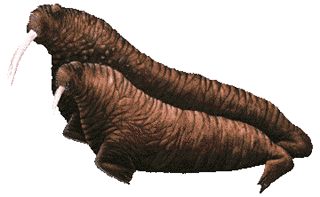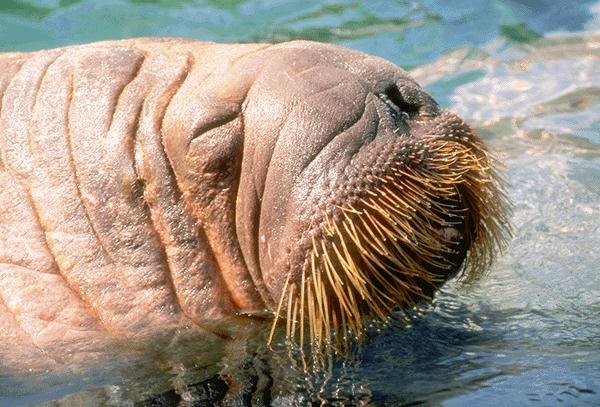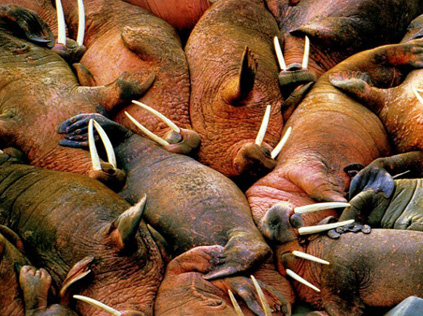
A single Recent species makes up this family, which was considerably more diverse in the past. Walruses are found in northern seas, usually above 58 degrees latitude, but occasionally straying further south.
There's no mistaking a walrus. Males are huge (up to over 1200 kg), while females are somewhat smaller (up to over 850 kg). Their bodies are heavy, appearing swollen. Their heads are round and they have broad muzzles, well endowed with thick vibrissae that appear to form a moustache. They lack external ears. The skin is thick and wrinkled, with underlying blubber that may reach 15 cm in thickness. The hide, usually brown or yellow brown in color, has scattered hairs. Walruses have large, paddle-like forelimbs, which extend about 1/4 the length of the body. Their hind limbs, like those of otariids, can be rotated under their bodies and are useful in locomotion on land. The plantar surfaces of both limbs are roughened, probably to provide traction on ice. A large baculum is present in males. This structure, which may exceed 60 cm in length, is said to frequently show signs of healed fractures.
The most conspicuous features of walruses are their tusks. These teeth are canines, which grow continuously and which may exceed 100 cm in length in males (60 cm in females). Enamel is present only at the tip of the tusk, and usually only for a brief time after it erupts. Most of the exposed tooth is dentine. The dental formula is 1/0, 1/1, 3/3, 0/0 = 18, but much variation exists among individuals. The cheek teeth are conical or flattened, perhaps specialized for crushing the mollusks and other marine invertebrates on which walruses feed.
The skulls of walruses have alisphenoid canals and enormous mastoid processes. These processes support the powerful neck muscles that pull the head downward. Walruses lack the prominent supraorbital prcoesses seen in otariids. The occipital condyles flare widely and are placed low along the foramen magnum. The bony eustachian tube is large. Walruses also have an unusually strongly developed symphysis joining the lower jaws.
Walruses are highly gregarious, forming herds of hundreds and sometimes more than 2000 individuals. They usually stay close to land or to ice masses, and they migrate seasonally as the position of the ice pack changes. Walruses are polygamous, but copulation takes place exclusively in the water. They are rapid, efficient swimmers and good divers, foraging at depths up to 90 m. Their senses of smell and hearing are poorly developed, but they have excellent vision, and the vibrissae on their snouts also provide tactile information. They are noisy animals out of water, bellowing and trumpeting, and it has been suggested that rasping and clicking noises made while swimming may indicate some use of echolocation.
 Atlantic walrus |
 walrus |
 walrus-close up and personal! |
 walrus-hanging out |
Superfamily Canoidea Family Canidae Family Ursidae Family Otariidae Family Odobenidae Family Procyonidae Family Mustelidae Family Phocidae Superfamily Feloidea Family Viverridae Family Herpestidae Family Hyaenidae Family Felidae<<<<<<<>>>>>>> ARTIODACTYLA CARNIVORA CETACEA CHIROPTERA DASYUROMORPHIA DERMOPTERA DIDELPHIMORPHI DIPROTODONTIA HYRACOIDEA INSECTIVORA LAGOMORPHA MACROSCELIDEA MICROBIOTHERIA MONOTREMATA NOTORYCTEMORPHIA PAUCITUBERCULATA PERAMELEMORPHIA PERISSODACTYLA PHOLIDOTA PRIMATES PROBOSCIDEA RODENTIA SCANDENTIA SIRENIA TUBULIDENTATA XENARTHRA
Email: eradani7@aol.com